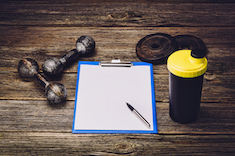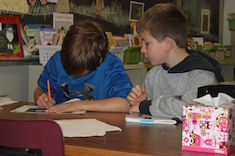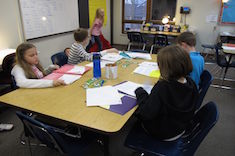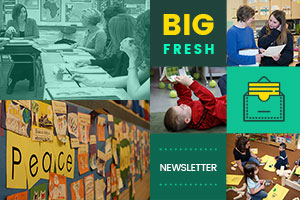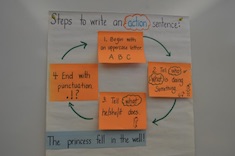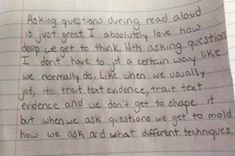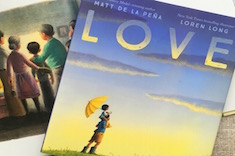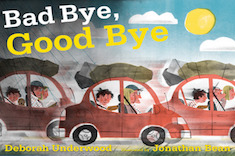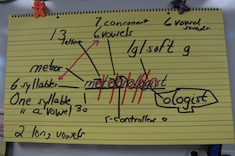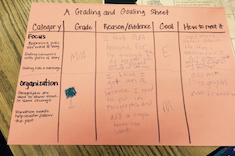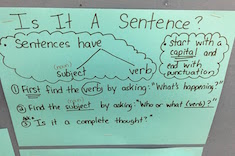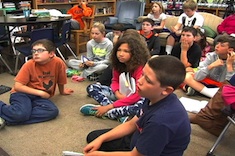Library
Choice Literacy Articles & Videos
The Choice Literacy library contains over 3,000 articles and 900 videos from 150+ contributors. Classic Classroom and Literacy Leadership subscribers have access to the entire library. Content is updated continuously, with five to six new features published each week.
Latest Content
Peer Support in Writing Workshop: Conferring with Jaden
Christy Rush-Levine meets with eighth grader Jaden, who talks through his struggles in writing a conclusion to his literary analysis, and how his peers helped him improve the writing.
The Writing Workout
Suzy Kaback meets with a group of teachers to talk through struggles in the writing workshops. Using a fitness analogy, they come up with strategies to try immediately in their classrooms.
Backward Chaining
How do you help students who are far behind their classmates in tackling writing projects, and have had years of learned helplessness in approaching complex tasks? Melanie Meehan takes on the challenge with a backward-chaining model.
Why We Like Independent Writing Projects
One way to get all students excited about writing workshop is through independent projects. Tara Barnett and Kate Mills explain why they devote many Fridays to independent projects. This is the first installment in a three-part series.
The Big Fresh March 24, 2018 Just Read
We look at ways to celebrate poetry in this week’s Big Fresh.
Eating Poetry
April is a month-long “thanksgiving” for those of us who love poetry. Shirl McPhillips shares her favorite resources for sharing that love with students.
Spoken Word Poetry
Gretchen Schroeder uses online videos as resources to teach her high school students to appreciate spoken-word poetry and write their own.
Object Poetry Lesson in Second Grade
Linda Karamatic explores poetry with her second graders. She displays poems students have written and teaches them about fresh language using a poem about a pencil sharpener.
The Big Fresh March 17, 2018 Finally Spring
We offer our annual top ten spring break of favorite articles in this week’s Big Fresh.
Forest Bathing
Shirl McPhillips explains how "forest bathing" is a wonderful entry point for writing, especially in early spring.
Grammar Instruction in Fourth Grade
Melanie Meehan coaches a fourth-grade teacher who is trying to improve his grammar instruction.
The Big Fresh March 10, 2018 Enough
We consider creative ways to teach grammar and editing in this week’s Big Fresh.
Choose Your Own Grammar Adventure
Gretchen Schroeder shares a quick exercise she’s developed for her high school students to hone grammar and editing skills using online video resources and individual Chromebooks.
Inspiring Students to Revise
Melanie Meehan uses revision strips to move young writers beyond "I'm done!" and into expanding and editing their writing.
How to Write a Sentence
Bitsy Parks realizes charts will help her first graders craft sentences. She shares how her sentence writing charts have changed over time.
The Big Fresh March 3, 2018 Irish Sushi
We look at read alouds in this week’s Big Fresh.
Writing Minilesson: Feelings
Katrina Edwards uses read alouds as mentor texts for writing minilessons in her first-grade classroom. In this example she focuses on character feelings.
Questioning Within Read Alouds
Melanie Meehan looks at the issue of engagement through the lens of student questions during read alouds, and shares a strategy to provoke more thoughtful student participation.
Leveraging Read Aloud
Christy Rush-Levine finds that administrators are questioning the value of read alouds, especially with older students. She shares how she uses the picture book Love in her middle school classroom to launch challenging discussions about timely themes.
End-of-Year Read Alouds
Bitsy Parks explains how the ending weeks of read alouds in her first-grade classroom are designed to celebrate learning and shared experiences from the entire year.
The Big Fresh February 24, 2018 Failure and Feedback
We look at assessment and grading in this week’s Big Fresh.
Building Stronger Wordsmiths
Maria Caplin is integrating vocabulary work into content areas.
Conferring in First Grade: Focus on Goals and Strengths
Katrina Edwards confers with first grader Wyatt about his goal of increasing the volume of his reading, helping him self-assess what’s going well and what lies ahead.
Meaningful Data
Ruth Ayres explains how data can make students and teachers feel empowered or deflated—so much depends on what you are looking for and how you present it.
Asking Students to Grade Themselves
Asking students to assess and grade their own work cements learning and deepens understanding for many students, but only if it is done in a thoughtful, collaborative way. Melanie Meehan takes you step-by-step through the process in a fifth-grade classroom.
Leveraging Reading Assessment Benchmarks
Benchmark assessments can be incredibly time-consuming for teachers to complete. Tara Barnett and Kate Mills describe how they leverage the time spent by using the assessments in strategy conferences with students.
The Big Fresh February 17, 2018 Memory Box
We look at how to foster student independence in this week’s Big Fresh.
An Editing Strategy for Run-On Sentences
Is your problem writers whose sentences never seem to end? Tara Barnett and Kate Mills have a strategy for grappling with run-on sentences.
Students Watching Teachers
Students are always watching us, whether we realize it or not. Jennifer Schwanke explains how we can capitalize on that interest to build independent reading and writing habits.
Big Question Minilesson
Katherine Sokolowski models how readers make choices as questions arise while reading independently. She also demonstrates how she moves between a novel and web resources.
Browse Content By
Type
Category
- Assessment Tools
- Big Fresh Archives
- Booklists
- Choice Numeracy
- Classroom Design
- Common Core
- Community Building
- Conferring
- Content Literacy
- Digital Literacy
- English Language Learners
- Equity
- Family Relations
- Free Samples
- Guiding Groups
- Leadership
- Literacy Coaches
- Mentor Texts
- Minilessons
- New Teacher Mentors
- Podcasts
- Poetry
- Quote Collections
- Reading Strategies
- Self Care
- Struggling and Striving Learners
- Talking and Listening
- Teacher Study Groups
- Teaching Reading
- Teaching Writing
- Word Study and Vocabulary
Author
- Melissa Quimby
- Nawal Qarooni
- Gwen Blumberg
- Julie Cox
- The Lead Learners
- Hannah Tills
- Josie Stewart
- Ruth Metcalfe
- Mallory Messenger
- Becca Burk
- Jodie Bailey
- Vivian Chen
- Mary Brower
- Tiffany Abbott Fuller
- Stephanie Affinito
- Ruth Ayres
- Leigh Anne Eck
- Heather Fisher
- Shari Frost
- Julie Johnson
- Suzy Kaback
- Gigi McAllister
- Shirl McPhillips
- Melanie Meehan
- Cathy Mere
- Debbie Miller
- Tara Barnett and Kate Mills
- Tammy Mulligan
- Dana Murphy
- Bitsy Parks
- David Pittman
- Brenda Power
- Heather Rader
- Matt Renwick
- Mandy Robek
- Christy Rush-Levine
- Gretchen Schroeder
- Jen Schwanke
- Brian Sepe
- Katherine Sokolowski
- Stella Villalba
- Jennifer Vincent
Grade Level
Choice Literacy Membership
Articles
Get full access to all Choice Literacy article content
Videos
Get full access to all Choice Literacy video content
Courses
Access Choice Literacy course curriculum and training


